NEW Lithium Battery Section II Declaration (For Shipper) 2015
- 格式:xls
- 大小:115.00 KB
- 文档页数:1
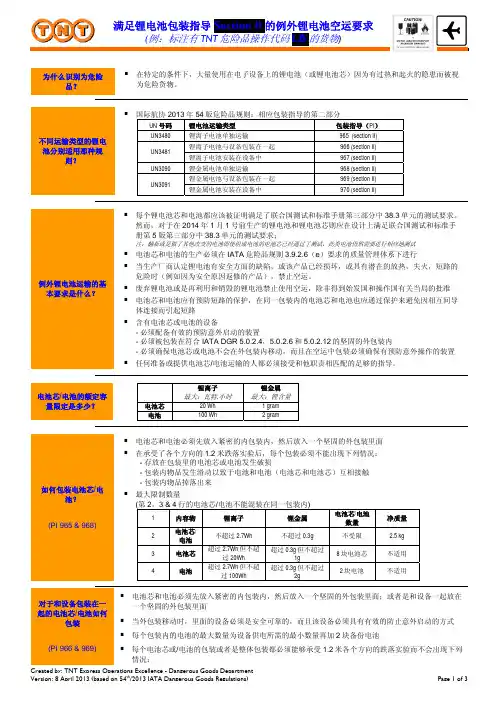
为什么识别为危险品? 在特定的条件下,大量使用在电子设备上的锂电池(或锂电池芯)因为有过热和起火的隐患而被视为危险货物。
不同运输类型的锂电池分别适用那种规则? 国际航协2013年54版危险品规则:相应包装指导的第二部分UN 号码锂电池运输类型包装指导(PI)UN3480 锂离子电池单独运输965 (section II)UN3481锂离子电池与设备包装在一起966 (section II)锂离子电池安装在设备中967 (section II) UN3090 锂金属电池单独运输968 (section II)UN3091锂金属电池与设备包装在一起969 (section II)锂金属电池安装在设备中970 (section II)例外锂电池运输的基本要求是什么? 每个锂电池芯和电池都应该被证明满足了联合国测试和标准手册第三部分中38.3单元的测试要求。
然而,对于在2014年1月1号前生产的锂电池和锂电池芯则应在设计上满足联合国测试和标准手册第5版第三部分中38.3单元的测试要求;注:翻新或是做了其他改变的电池即使组成电池的电池芯已经通过了测试,此类电池仍然需要进行相应地测试电池芯和电池的生产必须在IATA危险品规则3.9.2.6(e)要求的质量管理体系下进行当生产厂商认定锂电池有安全方面的缺陷,或该产品已经损坏,或具有潜在的放热,失火,短路的危险时(例如因为安全原因返修的产品),禁止空运。
废弃锂电池或是再利用和销毁的锂电池禁止使用空运,除非得到始发国和操作国有关当局的批准 电池芯和电池应有预防短路的保护,在同一包装内的电池芯和电池也应通过保护来避免因相互间导体连接而引起短路含有电池芯或电池的设备- 必须配备有效的预防意外启动的装置- 必须被包装在符合IATA DGR 5.0.2.4,5.0.2.6和5.0.2.12的坚固的外包装内- 必须确保电池芯或电池不会在外包装内移动,而且在空运中包装必须确保有预防意外操作的装置 任何准备或提供电池芯/电池运输的人都必须接受和他职责相匹配的足够的指导。
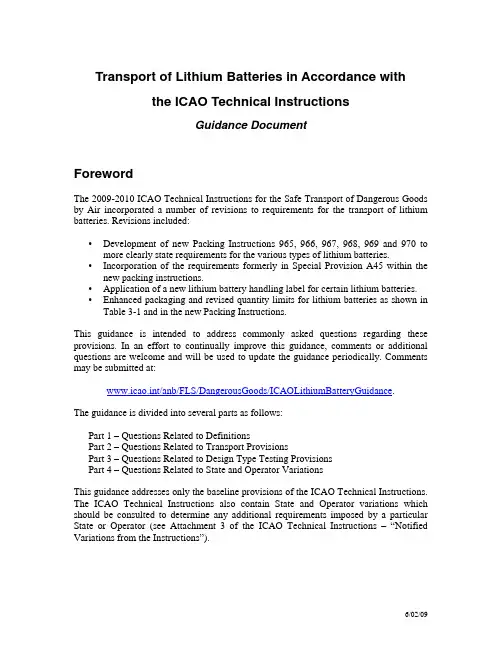
Transport of Lithium Batteries in Accordance withthe ICAO Technical InstructionsGuidance DocumentForewordThe 2009-2010 ICAO Technical Instructions for the Safe Transport of Dangerous Goods by Air incorporated a number of revisions to requirements for the transport of lithium batteries. Revisions included:• Development of new Packing Instructions 965, 966, 967, 968, 969 and 970 to more clearly state requirements for the various types of lithium batteries.• Incorporation of the requirements formerly in Special Provision A45 within the new packing instructions.• Application of a new lithium battery handling label for certain lithium batteries.• Enhanced packaging and revised quantity limits for lithium batteries as shown in Table 3-1 and in the new Packing Instructions.This guidance is intended to address commonly asked questions regarding these provisions. In an effort to continually improve this guidance, comments or additional questions are welcome and will be used to update the guidance periodically. Comments may be submitted at:www.icao.int/anb/FLS/DangerousGoods/ICAOLithiumBatteryGuidance.The guidance is divided into several parts as follows:Part 1 – Questions Related to DefinitionsPart 2 – Questions Related to Transport ProvisionsPart 3 – Questions Related to Design Type Testing ProvisionsPart 4 – Questions Related to State and Operator VariationsThis guidance addresses only the baseline provisions of the ICAO Technical Instructions. The ICAO Technical Instructions also contain State and Operator variations which should be consulted to determine any additional requirements imposed by a particular State or Operator (see Attachment 3 of the ICAO Technical Instructions – “Notified Variations from the Instructions”).Part 1 – Questions Related to DefinitionsA. What are the various types of lithium batteries?Lithium batteries fall into two broad classifications; lithium metal batteries and lithium ion batteries. Lithium metal batteries are generally non-rechargeable and contain metallic lithium. Lithium ion batteries do not contain metallic lithium and are rechargeable.B. What are lithium polymer batteries?A lithium polymer battery is a type of lithium ion battery. Generally, the main difference is lithium ion polymer batteries contain a polymer electrolyte.C. What is the difference between a lithium cell and a lithium battery?A lithium cell is a single encased electrochemical unit consisting of one positive and one negative electrode that exhibits a voltage differential across the two terminals. A lithium battery is one or more cells electrically connected. A single cell battery is considered a cell and not a battery.D. How are component cells connected to form a battery?Cells in batteries may be connected in parallel, in series, or in a combination of the two. When cells are connected in series the voltage of the battery increases but the capacity in ampere-hours (Ah) does not change. By contrast, when cells are connected in parallel the capacity in ampere-hours of the battery (Ah) increases but the voltage stays the same.E. How do I determine the watt hour rating for a particular lithium ion battery?The watt hour (Wh) rating is a measure by which lithium ion batteries are regulated. Lithium ion batteries manufactured after 1 January 2009 are required to be marked with the watt hour rating.You can also arrive at the number of watt-hours your battery provides if you know the battery’s nominal voltage (V) and capacity in ampere-hours (Ah):Ah x V = WhThis information is often marked on the battery.Note that if only the milli-ampere-hours (mAh) are marked on the battery then divide that number by 1000 to get ampere-hours (Ah) (i.e., 4400 mAh / 1000 = 4.4. Ah).Most lithium ion batteries marketed to consumers are below 100 watt-hours. If you are unsure of the watt-hour rating of your lithium ion battery, contact the manufacturer.Part 2 – Questions related to Packaging and Transport ProvisionsA. How do I safely package lithium batteries for transport?One of the major risks associated with the transport of batteries and battery-powered equipment is short-circuit of the battery as a result of the battery terminals coming into contact with other batteries, metal objects, or conductive surfaces. Packaged batteries or cells must be separated in a way to prevent short circuits and damage to terminals. They must be packed in a strong outer packaging or be contained in equipment. Sample packaging meeting these requirements is shown below:B. How can batteries be effectively protected against short circuit?Methods to protect against short circuit include, but are not limited to, the following methods:a) Packing each battery or each battery-powered device when practicable, in fullyenclosed inner packagings made of non-conductive material (such as a plastic bag);b) Separating or packing batteries in a manner to prevent contact with otherbatteries, devices or conductive materials (e.g., metal) in the packagings; andc) Ensuring exposed terminals or connectors are protected with non-conductive caps,non-conductive tape, or by other appropriate means.If not impact resistant, the outer packaging should not be used as the sole means of protecting the battery terminals from damage or short circuiting. Batteries should besecurely cushioned and packed to prevent shifting which could loosen terminal caps or reorient the terminals to produce short circuits.Terminal protection methods include but are not limited to the following:a) Securely attaching covers of sufficient strength to protect the terminals;b) Packaging the battery in a rigid plastic packaging; andc) Constructing the battery with terminals that are recessed or otherwise protected sothat the terminals will not be subjected to damage if the package is dropped.C. What does the new lithium battery handling label look like and when is itrequired?The new lithium battery handling label is required as specified in the additional requirements of Section II of packing instructions 965, 966, 967, 968, 969 and 970. The new label is as shown in Figure 5-31 of Part 5 of the ICAO Technical Instructions. The border of the label must have red diagonal hatchings with text and symbols in black on a contrasting background. The lithium battery handling label may be printed directly on the outer packaging provided that there is sufficient contrast between the elements of the lithium battery label and the colour of the packaging material.110 mm* Place for “Lithium ion battery” and/or “Lithium metal battery”D. When is a lithium battery handling label not required?A lithium battery handling label is not required for packages prepared in accordance with Section I of Packing Instructions 965-970 (i.e. bearing a Class 9 label) or when a package contains no more than 4 cells or 2 batteries installed in equipment prepared in accordance with Section II of Packing Instructions 967 and 970. This applies to UN 3481 Lithium ion batteries contained in equipment (See Section II of Packing Instruction 967) and UN3091 Lithium metal batteries contained in equipment (see section II of Packing Instruction 970). As these packages do not require a lithium battery handling label, the accompanying document mentioned in the Additional Packing Requirements of Section II of Packing Instructions 967 and 970 are not required.E. Is there a requirement for the Lithium Battery Handing Label to be available inlanguages other than English?English is generally the standard language accepted in international aviation. However, the State of Origin where offering the package for shipment may require their official language. Part 5;2.5 of the ICAO TI specifies that in addition to the languages which may be required by the State of Origin, English should be used.F. For the purposes of the lithium battery packing instructions, what is consideredthe "package"?The package is the complete product of the packing operation that satisfies the requirement of the packing instruction. The package may contain multiple batteries or pieces of equipment provided the limitations set out in the Packing Instruction are not exceeded. The package must be marked and labelled as required by the Packing Instruction. A single package may be offered for transport, or one or more packages may then be placed into an overpack for ease of handling or transport purposes. When an overpack is used, the package markings and labels must be duplicated on the overpack unless the markings and labels required on individual packages are visible, or are not required by the Packing Instruction (i.e. less than 4 cells or 2 batteries when contained in equipment).G. Please explain the documentation requirements for consignments of lithiumbatteries.Each consignment of packages with lithium batteries that is required to have the lithium battery handling label must be accompanied by a document such as an airway bill or other document that indicates:• The package contains lithium ion cells or batteries;• The package must be handled with care and that a flammability hazard exists if the package is damaged;• Special procedures should be followed in the event the package is damaged, to include inspection and repacking if necessary; and• A telephone number for additional information.This document may be in any form provided it contains all the appropriate information and accompanies the consignment. For example, the document may be provided separately to the carrier or in a pouch attached to the package.H. Does ICAO require an MSDS containing the UN test data?No. ICAO does not require the use of MSDS and test data is not part of the required documentation requirements when offering lithium batteries for transport.I. Section II in Packing Instructions 967 and 970 states that "Each packagecontaining more than four cells or more than two batteries installed in equipment must be labelled with a lithium battery handling label." What is the intent of this provision?This provision authorizes packages with equipment containing no more than 2 batteries or 4 cells to be offered for transport without the lithium battery handling label. For example, a package containing a notebook computer may have 1 lithium ion battery and 2 small lithium metal coin cells installed in the product. This single package does not require the lithium battery handling label. The number of cells contained inside the lithium ion battery are NOT counted towards the 4 cell limitation because it is the battery installed in the equipment being presented for transport. In addition, multiple packages each containing no more than 2 batteries or 4 cells may be overpacked and neither the individual packages nor the overpack would require the label.J. I have an MP3 player that contains one single-cell lithium ion battery pack. Do I have to label the shipping box that contains each MP3 player? What if I place five MP3 players in a shipping box? Does this require a label?For packages of single MP3 players, no lithium battery label would be required since you can place up to 4 of these single-cell batteries in a box without labelling the outer box. In the case where 5 MP3 players are in a shipping package, a lithium battery label on the outer shipping package would be required.K. Under Packing Instructions 966 and 969, it states that “The maximum number of batteries in each package must be the minimum number required to power the equipment, plus two spares”. If a package contains 4 power tools (each tool contains a lithium ion battery), can 2 extra lithium ion batteries be placed in the package for each piece of equipment for a total of 8 batteries?Yes. The 8 batteries reflect two spares for each of the 4 power tools in the outer package. L. Can a single label be used to identify that both lithium metal and lithium ion batteries are contained inside the package?Yes. A single label identifying both lithium ion and lithium metal batteries may be used.M. May lithium battery packages be placed in an overpack in accordance with the new ICAO Technical Instructions?Yes. The overpack may also contain packages of dangerous goods or goods not subject to these Instructions provided there are no packages enclosing different substances which might react dangerously with each other. An overpack must be labelled with the lithium battery label (Figure 5-31) of the ICAO Technical Instructions unless the label(s) on the package(s) inside the overpack are visible. In addition, the word “overpack” must be marked on overpacks containing packages transported in accordance with Section I of the applicable Packing Instructions (i.e. bearing Class 9 labels).N. Do the quantity limits shown in the ICAO packing instructions apply to overpacks containing lithium batteries?The quantity limits shown in packing instructions 965 and 968, refer to the package. Provided each package remains under the limit specified in the packing instruction, the overpack may exceed the specified limits.O. Packing Instructions 966 and 969 Section II include a requirement for a 1.2 meter drop test. What portion or portions of the package are subject to this test? The completed package containing batteries as prepared for transport in accordance with the relevant packing instruction must be capable of withstanding the 1.2 meter drop test. This could apply to a package solely containing batteries that is packaged in full compliance with the provisions of the packing instruction (to include the 1.2 meter drop test capability requirement) and is then overpacked with equipment and offered for transport (see item 2M for additional information related to overpacks). Or, it could apply to a package that includes batteries properly packed in inner packaging and equipment or other non-dangerous goods that are placed in a single outer packaging. The package that includes both the inner packaging containing batteries and the equipment must comply with the packing instruction to include meeting the capability to pass the 1.2 meter drop test.P. How do I transport prototype lithium cells and batteries that have not been UN Tested?Prototype lithium batteries may be transported by cargo aircraft if you do the following:1.Obtain approval by the competent authority of the origin country prior totransport;2.Place no more than 12 batteries or 24 cells in a package;3.Protect the cells and batteries from short circuiting;4.Pack each of the cells or batteries in an inner packaging inside an outer packagingthat completely surrounds the cells and batteries. All packaging and cushioning material must be non-conductive and non-combustible5.Place the cells and batteries in an outer drum or box made of metal, plastic orplywood that meets Packing Group I performance requirements.Q. Can I ship recalled, damaged or non-conforming cells or batteries?Lithium batteries, identified by the manufacturer as being defective for safety reasons, orthat have been damaged, that have the potential of producing a dangerous evolution of heat, fire or short circuit are forbidden for transport (e.g. those being returned to the manufacturer for safety reasons). The U.S. DOT has developed guidance for consumersand manufacturers for shipping recalled batteries. /Battery_Recall_Guidance.pdfBatteries which have some other defective feature (e.g., LEDs not showing charge, incorrect model number on label, or batteries not holding enough charge) could still be shipped by air. Also, laptops being returned may not have a defective battery, it may notmeet the needs of the customer, may be defective itself (but not the battery), etc. In these situations air transport would be permitted. The battery or equipment manufacturer should be contacted to determine the appropriate shipping method.R. What are the requirements for the telephone number on the lithium battery handling label?The telephone number should be of a person knowledgeable about the shipment but is not intended to be for the purposes of obtaining immediate emergency response guidance,and is therefore not required to be monitored at all times that the package is in transit. Itis acceptable for the number to be monitored during the company’s normal business hours in order to provide product-specific information relative to the shipment. However,it also is acceptable to use an emergency response, 24-hour phone number on the label.S. How do I protect against “inadvertant activation”?When batteries are contained in equipment, the equipment should be packaged in a manner that prevents unintentional activation or should have an independent means of preventing unintentional activation (e.g., packaging restricts access to activation switch, switch caps or locks, recessed switches, trigger locks, temperature sensitive circuit breakers, etc.). This requirement does not apply to devices which are intentionally activein transport (RFID transmitters, watches, sensors etc.) and which are not capable of generating a quantity of heat sufficient to be dangerous to packaging or personal safety.Part 3 – Questions Related to Design Type Testing ProvisionsA. Where can I find requirements related to testing of battery design types?The UN Manual of Tests and Criteria sets out specific tests that must be conducted oneach lithium cell or battery design type. Each test is intended to either simulate a common transportation occurrence such as vibration or changes in altitude or to test the integrity ofa cell or battery. You may obtain a copy of these testing requirements via the following website: /trans/danger/publi/manual/manual_e.html.B. What constitutes a design change requiring renewed design type testing?A cell or battery that differs from a tested design by more than 0.1 grams or 20 % to the anode, cathode or electrolyte is considered to be a design change. A change that would materially affect the test results is also a design change.Examples of design changes may include the use of a different type of cathode materialor a change in the battery’s geometry.Part 4 – Questions Related to State and Operator VariationsA. What additional requirements are imposed by US Variation 2?The United States restricts the transport of certain primary (non-rechargeable) lithium metal batteries, both packaged batteries and those packed with our contained in equipment, from transport on passenger carrying aircraft. In accordance with US Variation 2, primary (non-rechargeable) lithium metal batteries and cells (UN3090) are forbidden for transportation aboard passenger-carrying aircraft. Such batteries transported in accordance with Section I of Packing Instruction 968 must be labelled with the cargo aircraft only label. Such batteries transported in accordance with Section II of Packing Instruction 968 must be marked “PRIMARY LITHIUM BATTERIES — FORBIDDEN FOR TRANSPORT ABOARD PASSENGER AIRCRAFT” or “LITHIUM METAL BATTERIES — FORBIDDEN FOR TRANSPORT ABOARD PASSENGER AIRCRAFT”.Primary (non-rechargeable) lithium metal batteries and cells contained in or packed with equipment (UN3091) are forbidden for transportation aboard passenger-carrying aircraft unless:1) The equipment and the batteries and cells are transported in accordance withPacking Instruction 969 or 970, as appropriate;2) The package contains no more than the number of lithium metal batteries or cellsnecessary to power the intended piece of equipment;3) The lithium content of each cell, when fully charged, is not more than 5 grams;4) The aggregate lithium content of the anode of each battery, when fully charged, isnot more than 25 grams; and5) The net weight of lithium batteries does not exceed 5 kg (11 pounds).Primary (non-rechargeable) lithium metal batteries and cells contained in or packed with equipment (UN3091) and transported in accordance with Section I of Packaging Instruction 969 or 970 that do not conform to the above provisions are forbidden for transportation aboard passenger carrying aircraft and must be labelled with the cargo aircraft only label.Primary (non-rechargeable) lithium metal batteries and cells contained in or packed with equipment (UN3091) and transported in accordance with Section II of Packaging Instruction 969 or 970 that do not conform to the above provisions are forbidden for transportation aboard passenger carrying aircraft and must be marked “PRIMARY LITHIUM BATTERIES — FORBIDDEN FOR TRANSPORT ABOARD PASSENGER AIRCRAFT” or “LITHIUM METAL BATTERIES — FORBIDDEN FOR TRANSPORT ABOARD PASSENGER AIRCRAFT”.— — — — — — — —ATTACHMENTLITHIUM BATTERY PACKING INSTRUCTIONSPACKING INSTRUCTION 965+Passenger and cargo aircraft for UN 3480This entry applies to lithium ion or lithium polymer batteries in Class 9 (Section I) and lithium ion or lithium polymer batteries subject to specific requirements of these Instructions (Section II).SECTION ISection I requirements apply to each cell or battery type that has been determined to meet the criteria for assignment to Class 9.Each cell or battery must:1) be of the type proven to meet the requirements of each test in the UN Manual of Tests and Criteria,Part III, section 38.3; and2) incorporate a safety venting device or be designed to preclude a violent rupture under conditionsnormally incident to transport and be equipped with an effective means of preventing external shortcircuits.Each battery containing cells or a series of cells connected in parallel must be equipped with an effective means, as necessary, to prevent dangerous reverse current flow (e.g. diodes, fuses).General requirementsPart 4;1 requirements must be met.Package quantity (Section I)Contents Passenger CargoLithium ion cells and batteries 5 kg G 35 kg GADDITIONAL PACKING REQUIREMENTS— Lithium ion cells and batteries must be protected against short circuits.— Packagings must meet the Packing Group II performance requirements.— Lithium ion batteries with a mass of 12 kg or greater and having a strong, impact-resistant outer casing, or assemblies of such batteries, may be transported when packed in strong outer packagings and protective enclosures not subject to the requirements of Part 6 of these Instructions, if approved by the appropriate authority of the State of Origin. A copy of the document of approval must accompany the consignment.OUTER PACKAGINGSBoxes Drums JerricansAluminium (4B) Aluminium (1B2) Aluminium (3B2)Fibreboard (4G) Fibre (1G) Plastic (3H2)Natural wood (4C1, 4C2) Plastic (1H2) Steel (3A2)Plastic (4H2) Plywood (1D)Plywood (4D) Steel (1A2)Reconstituted wood (4F)Steel (4A)SECTION IILithium ion cells and batteries offered for transport are not subject to other additional requirements of these Instructions if they meet the requirements of this section.Lithium batteries, identified by the manufacturer as being defective for safety reasons, or that have been damaged, that have the potential of producing a dangerous evolution of heat, fire or short circuit are forbidden for transport(e.g. those being returned to the manufacturer for safety reasons).Lithium ion cells and batteries may be offered for transport if they meet the following:1) for lithium ion cells, the Watt-hour rating (see Attachment 2) is not more than 20 Wh;2) for lithium ion batteries, the Watt-hour rating is not more than 100 Wh;— the Watt-hour rating must be marked on the outside of the battery case except for those batteries manufactured before 1 January 2009, which may be transported in accordance with the provisions ofthis section and without the marking until 31 December 2010;3) each cell or battery is of the type proven to meet the requirements of each test in the UN Manual of Testsand Criteria, Part III, section 38.3.General requirementsBatteries must be packed in strong outer packagings that conform to Part 4;1.1.1, 1.1.3.1 and 1.1.9 (except 1.1.9.1).Package quantity(Section II)Contents Passenger CargoLithium ion cells and batteries 10 kg G 10 kg GADDITIONAL PACKING REQUIREMENTS— Cells and batteries must be packed in inner packagings that completely enclose the cell or battery.— Cells and batteries must be protected so as to prevent short circuits. This includes protection against contact with conductive materials within the same packaging that could lead to a short circuit.— Each package must be capable of withstanding a 1.2 m drop test in any orientation without:— damage to cells or batteries contained therein;— shifting of the contents so as to allow battery to battery (or cell to cell) contact;— release of contents.— Each package must be labelled with a lithium battery handling label (Figure 5-31).— Each consignment must be accompanied with a document such as an air waybill with an indication that: — the package contains lithium ion cells or batteries;— the package must be handled with care and that a flammability hazard exists if the package is damaged;— special procedures should be followed in the event the package is damaged, to include inspection and repacking if necessary; and— a telephone number for additional information.— Any person preparing or offering cells or batteries for transport must receive adequate instruction on these requirements commensurate with their responsibilities.OUTER PACKAGINGSBoxes Drums JerricansStrong outer packagings+PACKING INSTRUCTION 966Passenger and cargo aircraft for UN 3481 (packed with equipment) onlyThis entry applies to lithium ion or lithium polymer batteries packed with equipment in Class 9 (Section I) and lithium ion or lithium polymer batteries packed with equipment subject to specific requirements of these Instructions (Section II).SECTION ISection I requirements apply to each cell or battery type that has been determined to meet the criteria for assignment to Class 9.Each cell or battery must:1) be of the type proven to meet the requirements of each test in the UN Manual of Tests and Criteria,Part III, section 38.3; and2) incorporate a safety venting device or be designed to preclude a violent rupture under conditionsnormally incident to transport and be equipped with an effective means of preventing external shortcircuits.Each battery containing cells or a series of cells connected in parallel must be equipped with an effective means, as necessary, to prevent dangerous reverse current flow (e.g. diodes, fuses).General requirementsPart 4;1 requirements must be met.Package quantity(Section I)Contents Passenger CargoQuantity of lithium ion cells andbatteries per overpack, excluding5 kg 35 kgequipmentADDITIONAL PACKING REQUIREMENTS— Lithium ion cells and batteries must be protected against short circuits.— The completed package for the cells or batteries must meet the Packing Group II performance requirements. — The equipment and the packages of lithium cells or batteries must be placed in an overpack. The overpack must bear applicable marks and labels as set out in Part 5;1 and 5;2.4.10.— For the purpose of this packing instruction, “equipment” means apparatus requiring the lithium ion batteries with which it is packed for its operation.OUTER PACKAGINGSBoxes Drums JerricansAluminium (4B) Aluminium (1B2) Aluminium (3B2)Fibreboard (4G) Fibre (1G) Plastic (3H2)Natural wood (4C1, 4C2) Plastic (1H2) Steel (3A2)Plastic (4H2) Plywood (1D)Plywood (4D) Steel (1A2)Reconstituted wood (4F)Steel (4A)SECTION IILithium ion cells and batteries (including lithium polymer) packed with equipment offered for transport are not subject to other additional requirements of these Instructions if they meet the requirements of this section.Lithium batteries, identified by the manufacturer as being defective for safety reasons, or that have been damaged, that have the potential of producing a dangerous evolution of heat, fire or short circuit are forbidden for transport (e.g. those being returned to the manufacturer for safety reasons).Lithium ion cells and batteries may be offered for transport if they meet the following:1) for lithium ion cells, the Watt-hour rating (see Attachment 2) is not more than 20 Wh;2) for lithium ion batteries, the Watt-hour rating is not more than 100 Wh;— the Watt-hour rating must be marked on the outside of the battery case except for those batteries manufactured before 1 January 2009, which may be transported in accordance with the provisions ofthis section and without the marking until 31 December 2010;3) each cell or battery is of the type proven to meet the requirements of each test in the UN Manual of Testsand Criteria, Part III, section 38.3.General requirementsBatteries must be packed in strong outer packagings that conform to Part 4;1.1.1, 1.1.3.1 and 1.1.9 (except 1.1.9.1).ADDITIONAL PACKING REQUIREMENTS— Cells and batteries must be packed in inner packagings that completely enclose the cell or battery.— Cells and batteries must be protected so as to prevent short circuits. This includes protection against contact with conductive materials within the same packaging that could lead to a short circuit.— The maximum number of batteries in each package must be the minimum number required to power the equipment, plus two spares.— Each package must be capable of withstanding a 1.2 m drop test in any orientation without: — damage to cells or batteries contained therein;— shifting of the contents so as to allow battery to battery (or cell to cell) contact;— release of contents.— Each package must be labelled with a lithium battery handling label (Figure 5-31).— Each consignment must be accompanied with a document such as an air waybill with an indication that: — the package contains lithium ion cells or batteries;。
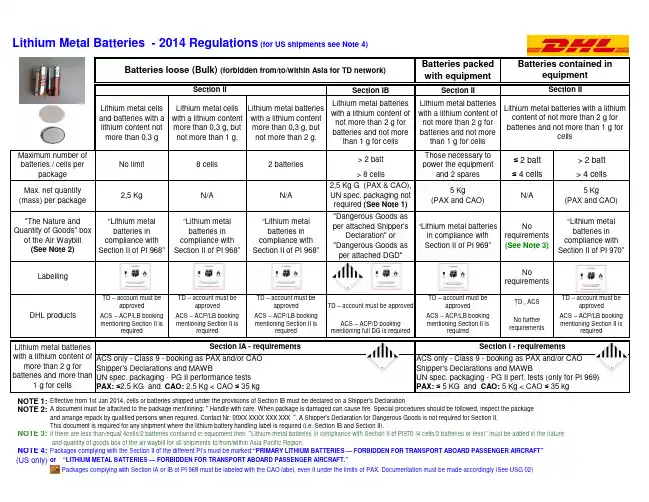
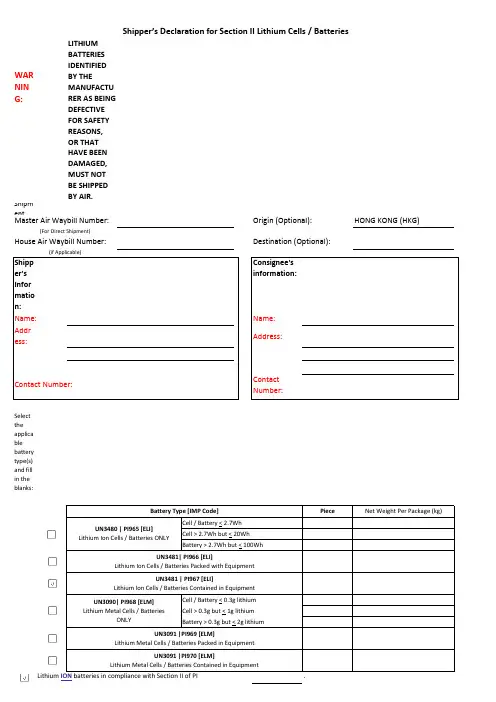
WAR NIN G:LITHIUM BATTERIES IDENTIFIED BY THEMANUFACTU RER AS BEING DEFECTIVE FOR SAFETY REASONS,OR THAT HAVE BEEN DAMAGED,MUST NOT BE SHIPPED BY AIR.Shipm entShipp er's Infor matio n:Consignee's information:Name:Addr ess:Address:Contact Number:Select the applica ble battery type(s)and fill in the blanks:PieceUN3091 |PI969 [ELM]Lithium Metal Cells / Batteries Packed in Equipment UN3480 | PI965 [ELI]Lithium Ion Cells / Batteries ONLYUN3481| PI966 [ELI]Lithium Ion Cells / Batteries Packed with Equipment UN3090| PI968 [ELM]Lithium Metal Cells / BatteriesONLYUN3481 | PI967 [ELI]Lithium Ion Cells / Batteries Contained in EquipmentUN3091 |PI970 [ELM]Lithium Metal Cells / Batteries Contained in EquipmentLithium ION batteries in compliance with Section II of PI Cell / Battery < 0.3g lithium Cell > 0.3g but < 1g lithium Battery > 0.3g but < 2g lithiumCell / Battery < 2.7Wh Cell > 2.7Wh but < 20Wh Battery > 2.7Wh but < 100WhContact Number:Battery Type [IMP Code]Net Weight Per Package (kg)Name:House Air Waybill Number:Destination (Optional):Shipper’s Declaration for Section II Lithium Cells / BatteriesMaster Air Waybill Number:Origin (Optional):HONG KONG (HKG)(For Direct Shipment).‧‧Special Procedur‧Telephon e (Country Code) +Area Code +‧Remarks:(CAPITALLETTERS)Date:BE REPACKED IF THEY ARE INTACT AND PROTECTED AGAINST SHORT CIRCUITS.MSDS Code:NAME:Lithium METAL batteries in compliance with Section II of PI This package must be handled with care. A flammability hazard exists if the package is damaged.Special procedures must be followed in the event the package is damaged, to include inspection and repacking if necessary.IF THIS PACKAGE IS DAMAGED IN TRANSPORTATION, IT MUST NOT BE LOADED UNTIL THE CONDITION OF THE CONTENTS CAN BE VERIFIED. THE BATTERIES CONTAINED IN THIS PACKAGE MUST BE INSPECTED FOR DAMAGE AND MAY ONLY。
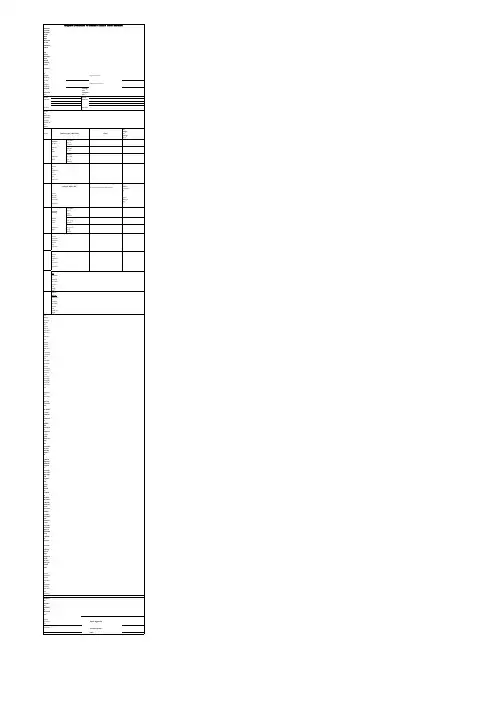
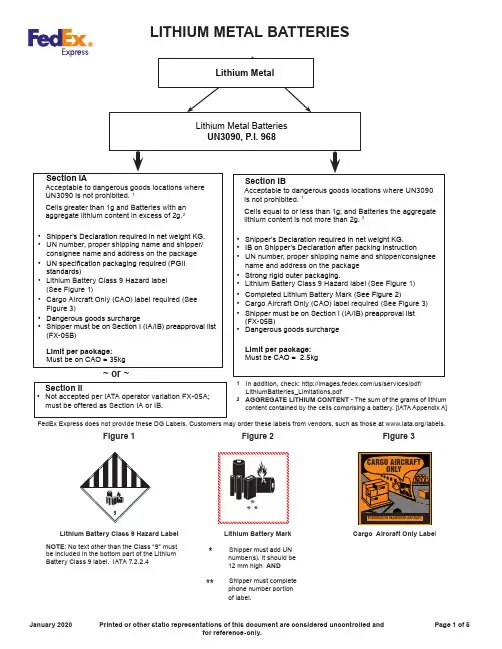
January 2020 Printed or other static representations of this document are considered uncontrolled and Page 1 of 5for reference-only.FedEx Express does not provide these DG Labels. Customers may order these labels from vendors, such as those at /labels.Figure 1Figure 2Figure 3***Lithium Battery Class 9 Hazard Label Lithium Battery MarkCargo Aircraft Only Labe lNOTE : No text other than the Class “9” must be included in the bottom part of the Lithium Battery Class 9 label. IATA 7.2.2.4***Shipper must add UN number(s). It should be 12 mm high AND Shipper must complete phone number portion of label.AGGREGATE LITHIUM CONTENT - The sum of the grams of lithium content contained by the cells comprising a battery. [IATA Appendix A]In addition, check: /us/services/pdf/LithiumBatteries_Limitations.pdf2 1January 2020 Printed or other static representations of this document are considered uncontrolled and Page 2 of 5for reference-only.LITHIUM METAL BATTERIESLithium Metal Batteries packed with equipmentUN3091, P.I. 969Lithium Metal Batteries contained in equipmentUN3091, P.I. 970AGGREGATE LITHIUM CONTENT - The sum of the grams of lithium content contained by the cells comprising a battery. [IATA Appendix A]2LITHIUM ION BATTERIESJanuary 2020 Printed or other static representations of this document are considered uncontrolled and Page 3 of 5for reference-only.In addition, check: /us/services/pdf/LithiumBatteries_Limitations.pdf1LITHIUM ION BATTERIESJanuary 2020 Printed or other static representations of this document are considered uncontrolled and Page 4 of 5for reference-only.January 2020Printed or other static representations of this document are considered uncontrolled andPage 5 of 5for reference-only.Note:•FedEx Express will not accept any item with an A183 Special Provision, even with a Competent Authority approval. Any battery powered device subject to a recall will only be accepted if the recall is not safety related and the battery does not have the potential to cause a fire or dangerous evolution of heat. [FX-04E]•Lithium Batteries (Section I/IA/IB and Section II) must not be shipped in the same package with the following Hazard Classes/Divisions:1.4,2.1, 3, 4.1, 4.2, 4.3, 5.1, 5.2, 8, or 2.2 with a Cargo Aircraft Only label. This includes All Packed in One and Overpacks.Exception: If the only lithium batteries are those contained in temperature control devices and the lithium batteries are Section II. The package must also not require the Lithium Battery Mark and ELB (FedEx Express DG handling code for Section II batteries) must not be selected in the automation device. [FX-05C]•Shippers sending any data loggers which remain active in flight (other than FedEx SenseAware) must be pre-approved. Contact theFedExDangerousGoods/HazardousMaterialshotlineat(901)375-6806oremail:*************************************process. [FX-05D]•Hoverboards or similar self-balancing vehicles will only be accepted from companies if new, in unopened original packaging. Used,refurbished balancing vehicles shipments form individuals, resellers or third party shipments will not be accepted. [FX-04F]•Call FedEx customer service and ask for the International Hotline/ Specialist to check on commodity acceptability for international shipments1In addition, check: /us/services/pdf/LithiumBatteries_Limitations.pdf•Select ELB in your FedEx automation device, if selection is available for any Section II UN3091 or UN3481 required to be labeledwith the Lithium Battery Mark.Class 9 Miscellaneous DangerousGoods Hazard Label Lithium Battery LabelObsolete effective 01/01/19The Class 9 label cannot be used as the hazard label for Section I/IA/IB shipments effective 01/01/19.The Lithium Battery Class 9 hazard label must be used instead.If you have questions please contact the Dangerous Goods/Hazardous Materials Hotline at (800) GOFEDEX and press “81” or say dangerous goods. Press “4” to reach next available agent.DISCLAIMER:This guide is based upon the 2020 IATA Dangerous Goods Regulations and provides a general overview of lithium battery shipping requirements. It does not provide complete shipping information. Consult the packing instruction and all applicable Special Provisions for the product being shipped.These materials are provided as a courtesy, to be used as guidelines to assist properly trained shippers. These materials do not alter, satisfy, or influence anygovernmental requirements. The contents of these materials are subject to change due to constant changes in government regulations. FedEx Express accepts noliability for loss or damage resulting from changes, errors, omissions, or misinterpretations of these materials.。
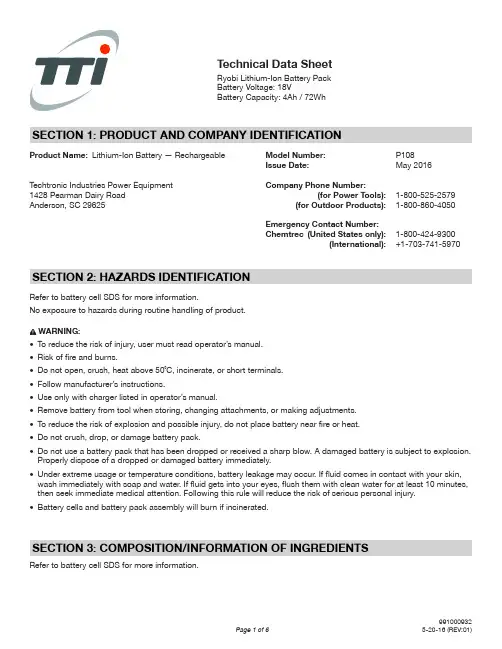
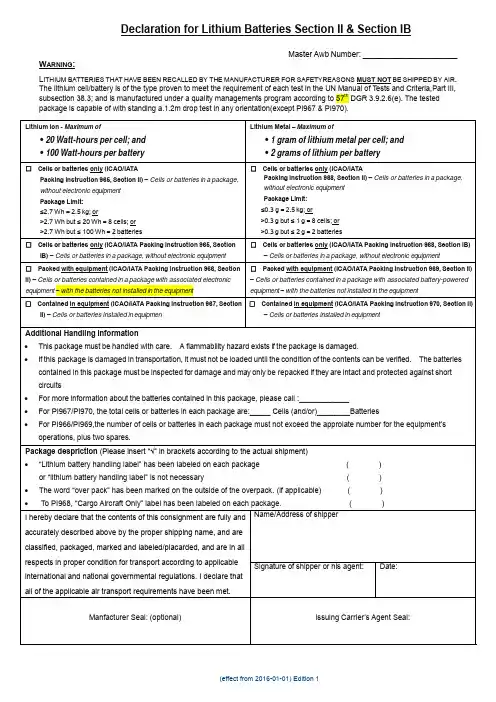
Declaration for Lithium Batteries Section II & Section IBMaster Awb Number:______________________ W ARNING:L ITHIUM BATTERIES THAT HAVE BEEN RECALLED BY THE MANUFACTURER FOR SAFETYREASONS MUST NOT BE SHIPPED BY AIR. The lithium cell/battery is of the type proven to meet the requirement of each test in the UN Manual of T ests and Criteria,Part III, subsection 38.3; and is manufactured under a quality managements program according to 57th DGR 3.9.2.6(e). The tested package is capable of with standing a.1.2m drop test in any orientation(except PI967 & PI970).Package Limit:≤2.7Wh=2.5kg;or>2.7Wh but≤ 20Wh=8cells;or >2.7Wh but≤ 100Wh=2batteriesPackage Limit:≤0.3g=2.5kg;or>0.3g but≤ 1g=8cells;or >0.3g but≤ 2g=2batteries□Cells or batteries only(ICAO/IATA Packing Instruction965,Section IB)–Cells or batteries in a package,without electronic equipment □Cells or batteries only(ICAO/IATA Packing Instruction968,Section IB)–Cells or batteries in a package,without electronic equipment□Packed with equipment(ICAO/IATA Packing Instruction966,Section II)–Cells or batteries contained in a package with associated electronic equipment –with the batteries not installed in the equipment □Packed with equipment(ICAO/IATA Packing Instruction969,Section II)–Cells or batteries contained in a package with associated battery-powered equipment–with the batteries not installed in the equipment□Contained in equipment(ICAO/IATA Packing Instruction967,Section II)–Cells or batteries installed in equipmen □Contained in equipment(ICAO/IATA Packing Instruction970,Section II)–Cells or batteries installed in equipmentAdditional Handling Information∙This package must be handled with care.A flammability hazard exists if the package is damaged.∙If this package is damaged in transportation,it must not be loaded until the condition of the contents can be verified.The batteries contained in this package must be inspected for damage and may only be repacked if they are intact and protected against short circuits∙For more information about the batteries contained in this package, please call :____________∙For PI967/PI970, the total cells or batteries in each package are:_____ Cells (and/or)________Batteries∙For PI966/PI969,the number of cells or batteries in each package must not exceed the approiate number for the equipment’s operations, plus two spares.Package despriction (Please insert “√” in brackets according to the actual shipment)∙“L ithium battery handling label” has been labeled on each package ( ) or “lithium battery handling label” is not necessary ( )∙The word “over pack” has been marked on the outside of the overpack. (if applicable)()∙To PI968, “Cargo Aircraft Only” label has been labeled on each package. ()I hereby declare that the contents of this consignment are fully and accurately described above by the proper shipping name, and are Name/Address of shipper关于锂电池Section II和Section IB空运声明主运单号_________________ 警告:因为安全隐患原因而被厂家召回的锂电池禁止空运本包装件内含有如下所列的锂电池或电池芯,该电池/芯已通过了联合国《危险品运输建议-实验和标准手册》第38.3章节测试;该锂电池的生产符合了IATA《危险品规则》57版3.9.2.6(e)中规定的质量管理程序;被测试的包装件能够承受1.2米跌落试2电池>0.3g but≤2g=2电池(ICAO/IATA包装说明965,包装件内只有电池或电池芯,没有设备□纯运输电池或电池芯(ICAO/IATAIB)–包装件内只有电池或电池芯,没有设备(ICAO/IATA 包装说明966,Section 电池或电池芯作为附件和电子设备包装在一个包装件内,该设备由电池驱动,且电池没有安装在设备□和设备包装在一起(ICAO/IATA–电池或电池芯作为附件和电子设备包装在一个包装件内,该设备由电池驱动,且电池没有安装在设备内(ICAO/IATA包装说明967, Section II) –电池或电池芯安装在设备中。
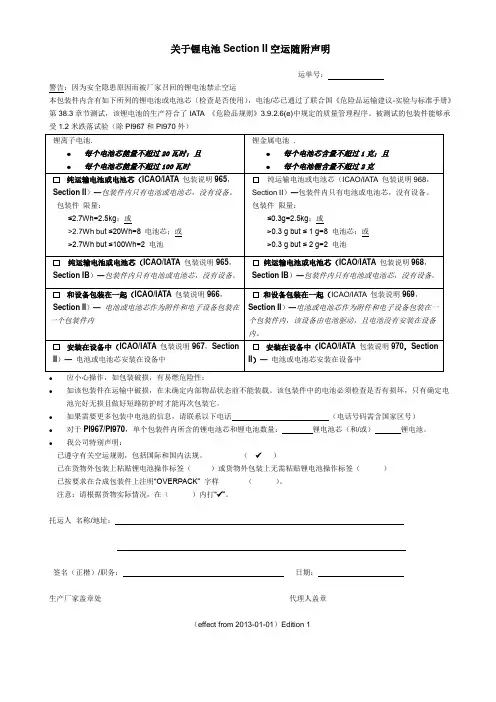
关于锂电池Section II空运随附声明运单号:警告:因为安全隐患原因而被厂家召回的锂电池禁止空运本包装件内含有如下所列的锂电池或电池芯(检查是否使用),电池/芯已通过了联合国《危险品运输建议-实验与标准手册》第38.3章节测试,该锂电池的生产符合了IATA 《危险品规则》3.9.2.6(e)中规定的质量管理程序。
被测试的包装件能够承受1.2米跌落试验(除PI967和PI970外)●应小心操作,如包装破损,有易燃危险性:●如该包装件在运输中破损,在未确定内部物品状态前不能装载。
该包装件中的电池必须检查是否有损坏,只有确定电池完好无损且做好短路防护时才能再次包装它。
●如果需要更多包装中电池的信息,请联系以下电话(电话号码需含国家区号)●对于PI967/PI970,单个包装件内所含的锂电池芯和锂电池数量:锂电池芯(和/或)锂电池。
●我公司特别声明:已遵守有关空运规则,包括国际和国内法规。
(✓)已在货物外包装上粘贴锂电池操作标签()或货物外包装上无需粘贴锂电池操作标签()已按要求在合成包装件上注明“OVERPACK” 字样()。
注意:请根据货物实际情况,在()内打“✓”。
托运人名称/地址:签名(正楷)/职务:日期:生产厂家盖章处代理人盖章(effect from 2013-01-01)Edition 1Declaration for Lithium Batteries section IIHAWB Number:WARNING:LITHIUM BATTERIES THAT HAVE BEEN RECALLED BY THE MANUFACTURER FORSAFETYREASOS MUSTNOT BE SHIPPED BY AIR.The Lithium cell/battery is of the type proven to meet the requirement of each test in the UN Manual of Tests and Criteria, Part III, subsection38.3. And is manufactured under a quality managements program according to DGR 3.9.2.6(e).the tested package is capable of with standing a.1.2m drop test in any orientation(except PI967&PI970)●This package must be handled with care. A flammability hazard exists if the package is damaged.●If this package is damaged in transportation, it must not be loaded until the condition of the contents can be verified. The batteriescontained in this package must be inspected for damage and may only be repacked if they are intact and protected against short circuits●For more information about the batteries contained in this package, call the following telephone number.●To PI967/970,how many cells or batteries in each package: Cells (and/or) batteries●I hereby declare thatAll of the applicable air transport requirements including applicable international and national governmentalregulations have been met. ( ✓)The “lithium battery handing label” has been labeled on each package. ( )or not need affix “lithium battery handing label” ( )The word “over pack” has been marked on the outside of the over pack ( )Attention:Please insert “✓” In brackets according to the actual shipmentName/Address of shipper:Signature(block letter) /Title: Date:Manufacturer Seal Agency Seal(effect from 2013-01-01)Edition 1。
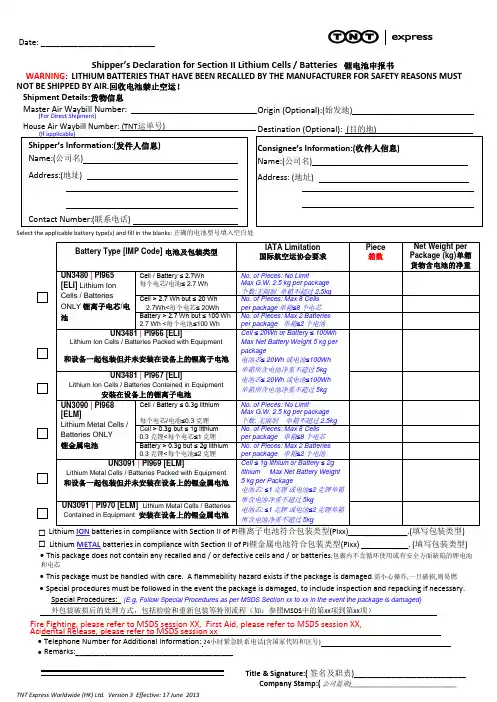
Date: _________________________Shipper ’s Declaration for Section II Lithium Cells / Batteries 锂电池申报书WARNING : LITHIUM BATTERIES THAT HAVE BEEN RECALLED BY THE MANUFACTURER FOR SAFETY REASONS MUST NOT BE SHIPPED BY AIR.回收电池禁止空运! Shipment Details:货物信息Master Air Waybill Number: (For Direct Shipment) House Air Waybill Number : (TNT 运单号)Select the applicable battery type(s) and fill in the blanks: 正确的电池型号填入空白处Origin (Optional):(始发地)_____________________Destination (Optional): (目的地)☐ LithiumI ON (PIxx) ___________.(☐ LithiumM ETAL batteries in compliance with Section II of PI 锂金属电池符合包装类型(PIxx) ____. (填写包装类型) ∙ This package does not contain any recalled and / or defective cells and / or batterie s.包裹内不含循环使用或有安全方面缺陷的锂电池和电芯∙ This package must be handled with care. A flammability hazard exists if the package is damaged .需小心操作,一旦破损,则易燃 ∙ Special procedures must be followed in the event the package is damaged, to include inspection and repacking if necessary. Special Procedures: (E.g. Follow Special Procedures as per MSDS Section xx to xx in the event the package is damaged)外包装破损后的处理方式,包括检验和重新包装等特别流程(如:参照MSDS 中的第xx 项到第xx 项)Fire Fighting, please refer to MSDS session XX, First Aid, please refer to MSDS session XX, Acidental Release, please refer to MSDS session xx∙ Telephone Number for Additional Information: 24小时紧急联系电话(含国家代码和区号)∙ Remarks:______________________________________Title & Signature:( 签名及职责)___________________________Company Stamp:( 公司盖章)________________________________TNT Express Worldwide (HK) Ltd. Version 3 Effective: 17 June 2013。
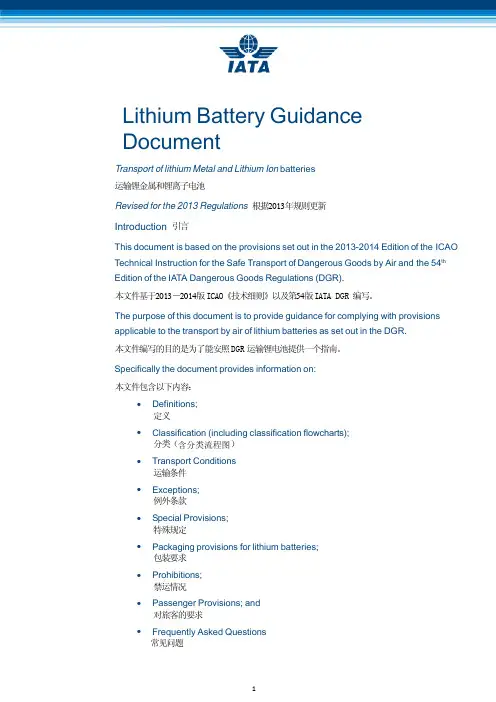
Packaging Battery Shipments Follow these instructions to help ensure safe transportation of your battery shipments and your shipments with items containing batteries within the FedEx Express® network.• U N 2795, Batteries, wet, filled with alkali (electric storage)• U N 2800, Batteries, wet, nonspillable (electric storage)General Wet Battery Packaging Guidelines • P ackage wet-cell batteries in containers, including metal containers, with acid/alkali leakproof liner — sealed to prevent leakage.• F asten batteries securely with fill openings and vents facing up to prevent short-circuiting or overheating.• P osition multiple batteries side by side, separated by nonconductive dividers.• P lace contents in a sturdy outer container.Shipping Nonspillable Wet BatteriesIn accordance with USG-11, an IATA (USG-11) nonspillable wet electric storage battery may be regarded as not subject to the regulations if the battery and its outer packaging are plainly and durably marked “NON S PILLABLE” or “NON S PILLABLE BATTERY.” The battery must also meet the conditions for being regarded as not subject to the regulations as prescribed in Special Provision A67, meaning that no shipper’s declaration is required.Unique Risks Associated With Shipping BatteriesBatteries provide the power source for personal computers, phones, automobiles, and life-saving appliances. However, batteries are classified as dangerous goods, because by definition they produce electricity from a chemical reaction. When improperly handled, packaged, or stored, batteries pose a risk for corrosive chemical and electrical fires. Emphasis must be placed on safety when packaging and transporting them. Following is an overview of the requirements for acceptance and transport of batteries with the FedEx Express system.Preparing Charged Batteries for ShipmentAt FedEx Express, we understand the importance of ensuring the safe transport of your shipments. Charged battery shipments or shipments with items that contain charged batteries may overheat and ignite in certain conditions and, once ignited, may be difficult to extinguish or may expend corrosive substances.By following these guidelines and complying with allapplicable local, state, and federal laws governing packing, marking, and labelling, you can do your part to help ensure your shipments arrive safely and on time to their final destinations. FedEx Express strictly adheres to International Air Transport Association (IATA) and International Civil Aviation Organization (ICAO) regulations.Shipping Wet BatteriesWet batteries or wet-cell batteries are typically filled with corrosive acid or alkali and are regulated battery shipments (Class 8 — Corrosive). Wet batteries are common in vehicles, utility systems, un-interruptible power systems, and industrial machinery. These commodities must be correctly identified, classified, packaged, marked, and labelled. Additionally, the package must have the Shipper’s Declaration for Dangerous Goods completed and signed by a trained shipper. UN Numbers and Proper Shipping Names for Wet Batteries • U N 2794, Batteries, wet, filled with acid(electric storage)Multiple batteries Sealed acid/alkali leakproof linerNonconductive dividersSturdy outer boxShipping Dry BatteriesDry batteries are sealed, nonvented batteries used in flash-lights or small appliances. They contain zinc salts and other solids or may be packed in combination with other metals. These batteries include non-rechargeable alkaline batteries and rechargeable batteries made with nickel metal hydride and nickel cadmium. Some dry batteries are regulated battery shipments (Class 4 — Dangerous When Wet or Class 8 — Corrosive) and must be correctly identified, classified, packaged, marked, and labelled. UN Numbers and Proper Shipping Names for Dry Batteries• U N 3028, Batteries, dry, containing potassium hydroxide, solid (electric storage)• U N 3292, Batteries, containing sodium General Dry Battery Packaging Guidelines• P osition multiple batteries or packages of batteries side by side, separated by dividers.• M ake sure batteries contained in an electronic device remain inside the device when shipping.• P ack securely and fill void spaces to prevent shifting or movement in transit.• P lace contents in a sturdy outer container.Shipping Lithium BatteriesLithium batteries are commonly used in devices like mobile phones, laptops, PDAs, watches, cameras, and even children’s toys. Lithium battery shipments or shipments with items that contain charged batteries may overheat and ignite in certain conditions and, once ignited, may be difficult to extinguish. The two main types of lithium batteries are lithium metal (primary non-rechargeable) and lithium ion (rechargeable).UN Numbers and Proper Shipping Names for Lithium Batteries• U N 3480, Lithium ion batteries• U N 3481, Lithium ion batteries packed with equipment • U N 3481, Lithium ion batteries contained in equipment • U N 3090, Lithium metal batteries• U N 3091, Lithium metal batteries packed with equipment • U N 3091, Lithium metal batteries contained in equipment Lithium metal batteries (primary non-rechargeable),UN 3090 prepared in accordance with Section IA, Section IB, and Section II of IATA packaging instruction 968 require approval prior to shipping by FedEx Express (operator variation FX-07).FedEx Express will not accept lithium battery shipments containing or overpacked with items identified as Class or Division 1, 2.1, 2.2 (if CAO), 3, 4, 5, and 8, whether primary or subsidiary risk.Section II IATA Lithium Battery ShipmentsAll packages containing lithium batteries are classified as Class 9 — Miscellaneous Dangerous Goods. However, packages containing small amounts of lithium may be exempted from most of the IATA and ICAO requirements if they comply with the requirements in Section II IATA (which matches Section II ICAO) Packing Instructions (PI) 965, 966, and 967 for lithium ion batteries and 968, 969, and 970 for lithium metal batteries as appropriate.Shipments of lithium metal batteries, lithium metal batteriespacked with equipment, and lithium metal batteriesMultiple packages of batteriesCushioning to fill void spaces Nonconductive dividersSturdy outer boxIf shipping loose batteries, package them side by side with dividers between each battery.Batteries should be shipped inside of the Fill void spacescontained in equipment may be packaged in accordance with Section II IATA (Section II ICAO) packaging requirements provided that the metal or alloy cell content does not exceed more than 1g, and the aggregate lithium content does not exceed 2g per cell.Lithium ion cells and batteries meeting the requirements of Section II must meet the general requirements of the packag-ing instruction. For lithium ion or polymer cells, the watt-hour rating is not more than 20Wh and 100Wh per battery. Each of the six proper shipping names defined in Section II IATA may have additional requirements related to typesof approved outer packaging, weight limits, and package droptests of 1.2m.Fully regulated lithium battery outer packaging mustmeet Packing Group II performance standards. (See Packaging Requirements as outlined in IATA Dangerous Goods Regulation.)Section II Lithium Battery Packaging GuidelinesTo comply with Section II IATA shipping requirements, shipments containing lithium batteries and cells must comply with specific packaging guidelines.• E nsure that lithium batteries are individually packaged in fully enclosed inner packaging such as a plastic blister wrap or pasteboard to provide protection for each battery.• S hield and protect lithium batteries to prevent short circuits or contact with conductive materials within the packaging that could cause short circuits.• E nsure that packaging is proven (i.e., tested) to meet the requirements of each test in the UN Manual of Tests and Criteria, Part III, Sub-Section 38.3.• M ake sure that lithium batteries are completely enclosed (such as in equipment or surrounded by plastic with void space filled to prevent movement), except when the proper shipping names end with “contained in equipment.”• P lace contents in a sturdy outer container.• P rovide correct labelling and documentation.Section IA IATA Lithium Battery ShipmentsLithium batteries, both lithium ion and lithium metal, arefully regulated dangerous goods when prepared under Section IA IATA regulations. These commodities must be correctly identified, classified, packaged, marked, and labelled. Additionally, the package must have the Shipper’s Declaration for Dangerous Goods completed and signed by a trained shipper. Section IB IATA Stand-Alone Lithium Battery Shipments Section IB requirements apply to lithium metal cells with a lithium metal content not exceeding 1g and lithium metal batteries with a lithium metal content not exceeding 2g packed in quantities that exceed the allowance permitted in Section II, Table 968-II. All 1B shipments are required to have a Shipper’s Declaration for Dangerous Goods, and “1B” must be indicated after Packing Instruction either in the Packing Instruction section or in Authorization. Alternate documentation willnot be allowed. Refer to packaging instructions 965 and 968. CushioningLithium metal batteryin blister packNonconductive dividersSturdy outer boxSection II lithium batteryhandling labelFedEx lithium battery handling labelSealing and Labelling Instructions Although these instructions are not regulatory requirements, they represent FedEx best practices when shipping with corrugated boxes.• U sing the H taping method, apply at least three strips of pressure-sensitive adhesive plastic tape that is at least 2" wide to both the top and bottom of the carton.• T ape all seams or flaps.• P lace the shipping label on the top of the largest side.• E nsure that all required outer markings, labellings, and documentation appear.Battery Shipment Restrictions and RegulationsFedEx Express will not accept or ship:• R ecalled or defective batteries, either as a stand-alone unit or contained with equipment.• R ecalled or defective lithium batteries contained in electronic equipment, such as a laptop.• W aste batteries or batteries being shipped for recycling or disposal. (See IATA Special Provisions A154 and A183 as well as FX-16 for additional details on these restrictions.)(See IATA Special Provision A154 for additional details on these restrictions.)FedEx Office ® locations and FedEx Ship Centre locations do not accept regulated battery shipments, with the exception of lithium battery shipments meeting Section II IATA regulations.FedEx Packaging ServicesWe offer free package evaluation services, and we encourage you to submit a sample of your packaging for evaluation.Contacts and Resources• H ow to Pack guidelines at fedex.ca/packaging . • F edEx Dangerous Goods Hotline; call 1.800.GoFedEx 1.800.463.3339 and say “dangerous goods.”NOTICE:FedEx Express will refuse to accept packages that do not meet FedEx Express, government, or IATA andICAO requirements.While we cannot ensure compliance with markings such as up arrows or “This End Up,” properly placing the shipping label increases your chance for the preferred orientation.H taping methodThis brochure is in no way intended to replace requirements mandated by 49CFR and IATA. This is for informational purposes only. This packaging brochure is provided to FedEx customers to help reduce loss or damage due to improper packaging. It is NOT intended to be a comprehensive guide for packaging items we accept for transit. We make no warranties, expressed or implied, regarding this information. Proper packaging is the sole responsibility of the shipper. For more information and comprehensive guidelines, contact the FedEx Dangerous Goods Hotline at 1.800.GoFedEx 1.800.463.3339 and say “dangerous goods.” (Outside the U.S., request to speak to a dangerous goods representative.) Refer to the current FedEx Service Guide at fedex.ca for terms, conditions, and limitations applicable to FedEx ® delivery services.© 2016 FedEx. All rights reserved.。
Shipper’s Declaration for Section II Lithium Cells / Batteries WARNING: LITHIUM BATTERIES IDENTIFIED BY THE MANUFACTURER AS BEING DEFECTIVE FOR SAFETY REASONS, OR THAT HAVE BEEN DAMAGED, MUST NOT BE SHIPPED BY AIR. Shipment Details:FedEx Air Waybill Number: Origin:HK Destinati on: USAShipper’s Information:Consignee’s Information:Name: Fly lang import and export co., LTD-lishu Name: Brian CrandallAddress:Fly lang import and export co., LTD Address:300 RESERVOIR ROADyiwu 3 area 18 building 3 unit GOSHEN NY 10924 USA Contact Number: Contact Number:Battery Type [IMP Code] Pieces Net (Kg) per Package (Lithium Cell / Battery)UN3480 PI965 [ELI] Cell / Battery ≤ 2.7WhLithium Ion Cells / Batteries Cell > 2.7Wh but ≤ 20WhONLY Battery > 2.7Wh but ≤ 100WhUN3481 PI966 [ELI]Lithium Ion Cells / Batteries Packed with EquipmentUN3481 PI967 [ELI]Lithium Ion Cells / Batteries Contained in EquipmentUN3090 PI968 [ELM] Cell / Battery ≤ 0.3g lithium contentLithium Metal Cells / Batteries Cell > 0.3g but ≤ 1g lithium contentONLY Battery > 0.3g but ≤ 2g lithium cont entUN3091 PI969 [ELM]Lithium Metal Cells / Batteries Packed with EquipmentUN3091 PI970 [ELM]Lithium Metal Cells / Batteries Contained in EquipmentLithium ION batteries in compliance with Section II of PILithium METAL batteries in compliance with Section II of PIThis package does not contain any recalled and/or defective cells or batteriesThis package must be handled with care and that a flammability hazard exists if the package is damaged.Special procedures must be followed in the event the package is damaged, to include inspection and repacking if necessary.Special Procedures:Telephone Number for Additional Information(Country Code) + Area Code + Phone number Remarks:Name & Date: 10-Mar-2016(CAPITAL LETTERS)FedEx Express - Updated March 1, 2016。
东航锂电池运输咨询通告一、制定依据1. IATA《危险品规则》57版 (以下简称IATA《DGR》)2. ICAO Doc9284-AN/905《危险物品安全航空运输技术细则》(2015-2016) (以下简称ICAO 《TI》)3.《中国民用航空危险品运输管理规定》(CCAR-276-R1)二、空运限制条件1.UN38.3测试除原型样品锂电池外,任一型号的锂电池芯或锂电池(无论锂电池所含的电池芯是否经过了UN38.3要求的系列测试),在交付航空运输前,均应通过UN38.3要求的系列测试。
2.特殊规定A88批准运输原型样品锂电池芯或电池应获得始发国主管当局的书面批准,方可根据ICAO Doc9284-AN/905和 IATA《危险品规则》特殊规定A88条款的相关要求进行航空运输。
未经过UN38.3测试的低产量(即年度生产量不超过100块)的锂电池或电池芯,应根据A88条款的规定获得批准后方可运输。
3.禁止运输(1)任一特定型号的锂电池芯或锂电池,如果既未经过第1条款要求的UN38.3测试,也没有第2条款规定的A88批准文件,不应进行航空运输。
(2)根据ICAO《TI》和IATA《DGR》特殊规定A154条款,因为安全原因被制造商确认为有缺陷或已被损坏的锂电池(例如因安全原因被生产商召回的电池),有可能会演变发生发热、燃烧和短路的潜在危险,不应进行航空运输。
(3)根据ICAO《TI》和IATA《DGR》特殊规定A183条款,禁止航空运输废电池和为回收或处理目的而运输的电池,除非获得了始发国和运营人所属国主管当局的书面批准。
(4)严禁超出东航《危险品航空运输许可》批准范围运输锂电池货物。
(5)始发国、中转国、目的地国、航空运营人所在国及航空运营人声明禁止运输的锂电池,不应进行航空运输。
三、锂电池作为行李运输1.行李类型内含锂电池的个人自用电子设备和便携式电子医疗装置,可置于托运行李、手提行李或随身携带运输,备用锂电池应置于手提行李或随身携带运输,严禁托运。